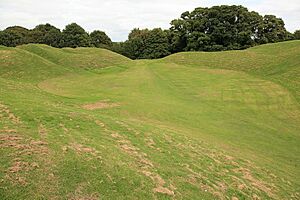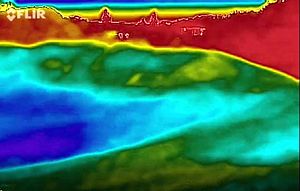Cirencester Amphitheatre facts for kids
The Cirencester Amphitheatre was a large Roman amphitheatre located in Cirencester, Gloucestershire, England. Today, its remains are protected as an ancient monument, meaning they are an important historical site.
This ancient structure was built around the beginning of the 2nd century. It was a place where Romans gathered to watch exciting events. These often included gladiator fights and animal shows.
What it Looked Like
Archaeologists have studied the site carefully. They found that the amphitheatre was built using large mounds of earth, called earthworks. These earthworks still show the shape of the original building.
The banks of the amphitheatre rise about 25 feet (7.6 meters) from the bottom of the arena. The arena itself, where the events took place, was about 150 feet (45.7 meters) long and 135 feet (41.1 meters) wide. During digs, Roman items like coins and pottery have been found here.
A Major Roman Site
In Roman Britain, Cirencester was known as Corinium Dobunnorum. It was the second largest town in Britain, after Londinium (London). Because of this, the Cirencester Amphitheatre was also the second largest in Britain. This shows how important Corinium was during Roman times.
The amphitheatre had tiered wooden seats for about 8,000 people. These seats were placed on stone terraces. It is possible that an earlier version of the amphitheatre, made only of timber, existed before the 2nd century. There were two main entrances, one at the north-east and one at the south-west.
Later Uses
Around the 5th century, the Western Roman Empire faced many attacks. Roman soldiers returned to Rome to defend their homeland. Because of this, the Cirencester Amphitheatre was changed to help defend against invading Saxons. Wooden structures were built inside the arena, and the north-east entrance was partly blocked.
Unlike many other Roman amphitheatres, this one was built in line with the streets of the town. In later times, people sometimes called it the 'Bull Ring'. This was because a sport called bull-baiting used to happen there.
Protecting the Past
In 2012, the Cirencester Town Council announced plans to make the site better for visitors. They wanted to improve access and add more signs. Later, in 2014, there were further plans for a visitor centre and a car park. These efforts help protect this important piece of Roman history for everyone to enjoy.
See also



